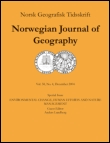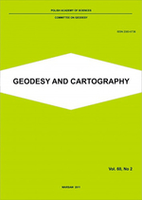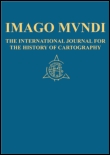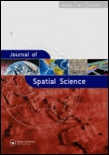
International Journal of Cartography
Scope & Guideline
Navigating the Future of Geography and Planning
Introduction
Aims and Scopes
- Innovative Cartographic Methodologies:
The journal focuses on the development and application of new methodologies in cartography, including digital mapping techniques, spatial analysis, and the use of advanced technologies such as GIS and machine learning. - Interdisciplinary Approaches:
Papers often explore the intersection of cartography with other fields such as art, sociology, and environmental science, highlighting the role of maps in understanding complex socio-environmental issues. - Historical and Cultural Perspectives:
The journal includes research on historical cartography and the cultural implications of mapping practices, contributing to the understanding of how maps reflect and shape societal narratives. - Sustainable Development and Social Impact:
There is a consistent focus on the role of cartography in promoting sustainable development goals (SDGs) and addressing social issues, emphasizing the importance of maps in advocacy and community engagement. - User Interaction and Experience:
Research often investigates the relationship between users and maps, including studies on map usability, user experience, and the cognitive aspects of map interpretation.
Trending and Emerging
- Digital and Interactive Cartography:
There is a growing emphasis on digital mapping technologies and interactive cartography, including the use of augmented reality and web-based mapping platforms, reflecting the demand for more engaging and user-friendly map experiences. - Data-Driven Mapping and Visualization:
The use of big data and advanced visualization techniques is on the rise, with researchers exploring how to effectively represent complex datasets through innovative cartographic methods. - Social Cartography and Community Engagement:
Emerging studies focus on the role of cartography in social movements and community advocacy, emphasizing participatory mapping and the use of maps to address social justice issues. - Sustainability and Environmental Mapping:
Research addressing the mapping of ecological and environmental issues, including climate change and resource management, is increasingly prevalent, linking cartography to global sustainability efforts. - Neurocartography and Cognitive Mapping:
Recent interest in the cognitive aspects of map use, including how people perceive and interact with maps, signifies a trend towards understanding the psychological dimensions of cartography.
Declining or Waning
- Traditional Cartographic Techniques:
There is a noticeable decline in papers focused solely on traditional cartographic techniques, such as manual map drawing or analog methods, as the field increasingly embraces digital technologies and automated processes. - Static Maps:
Research on static, paper-based maps is becoming less prominent, with more emphasis on interactive and dynamic mapping solutions that cater to the evolving needs of users in a digital age. - Historical Maps without Contemporary Context:
While historical analysis remains important, there is a waning interest in studies that do not connect historical maps to contemporary issues or technological advancements, as the field shifts towards relevance and application. - Geographic Information Systems (GIS) Basics:
Basic GIS methodologies are increasingly viewed as foundational knowledge, leading to a decline in papers that cover introductory GIS topics without new insights or applications. - Purely Theoretical Cartography:
There is a trend away from purely theoretical discussions in cartography that lack empirical research or practical applications, as the journal prioritizes studies with tangible outcomes.
Similar Journals

Norsk Geografisk Tidsskrift-Norwegian Journal of Geography
Unveiling the dynamics of our changing world.Norsk Geografisk Tidsskrift-Norwegian Journal of Geography, published by Routledge Journals, Taylor & Francis Ltd, is a pivotal peer-reviewed journal that has been instrumental in advancing the field of geography since its inception in 1926. With an esteemed Q2 ranking in both Earth and Planetary Sciences and Geography, Planning and Development categories, it serves as a vital resource for researchers, professionals, and students seeking to deepen their understanding of geographical phenomena. The journal's rich historical archive, covering significant periods in geography and environmental studies, showcases a diverse array of articles that reflect ongoing research trends and challenges within the field. Despite not offering Open Access, its impactful content remains accessible through institutional subscriptions, underscoring the journal's commitment to advancing geographical research and fostering scholarly dialogue. As it continues to publish high-quality research, Norsk Geografisk Tidsskrift stands as a key player in geographical scholarship, reinforcing its importance within the academic community.

CyberGeo-European Journal of Geography
Connecting Scholars Through Open Access GeographyCyberGeo-European Journal of Geography, published by CYBERGEO, is a leading open-access journal that has been at the forefront of geographical research since its inception in 1996. With a dedicated focus on the multifaceted dimensions of geography, the journal aims to disseminate innovative and critical insights into geographical phenomena in Europe and beyond. The journal has established itself in the academic community, currently holding the Q3 quartile ranking in the Social Sciences (miscellaneous) category for 2023 and recognized within Scopus as #428 out of 604, placing it in the 29th percentile. CyberGeo publishes original research articles, thematic issues, and reviews that contribute to the advancement of geographical knowledge, making it an essential resource for researchers, professionals, and students alike. Situated in Paris, France, the journal embraces a truly international perspective and invites contributions that stimulate scholarly debate and further the understanding of spatial dynamics. By providing open access to its content, CyberGeo ensures that its research is accessible to a global audience, promoting knowledge sharing and collaborative exploration in the field of geography.

Geodesy and Cartography
Innovating Mapping Practices for Tomorrow's DiscoveriesGeodesy and Cartography, published by the Polska Akademia Nauk (Polish Academy of Sciences), is a premier open-access journal dedicated to advancing the fields of geodesy, cartography, and geographic information science. Since its inception in 2010, the journal has provided a vital platform for researchers, professionals, and students to share their findings, fostering innovation and collaboration in these critical areas of study. With its ISSN 2080-6736 and E-ISSN 2300-2581, the journal is accessible to a global audience, ensuring that cutting-edge research is readily available to enhance scientific understanding and application. The journal not only serves as a repository of knowledge but also aims to contribute to the development of best practices and methodologies within geospatial sciences, making it an essential resource for anyone invested in the ever-evolving landscape of mapping and spatial data analysis.

Information Geographique
Illuminating Geographic Phenomena through ResearchInformation Geographique is a prominent academic journal dedicated to the field of geographic information science, published by the esteemed ARMAND COLIN. With its ISSN 0020-0093 and E-ISSN 1777-5876, this journal serves as a critical platform for the dissemination of innovative research, addressing the multifaceted aspects of geography and spatial analysis. Information Geographique aims to foster a deeper understanding of geographic phenomena and promote interdisciplinary dialogue among researchers, professionals, and students. Although it does not currently offer open access options, the journal's rich content encompasses studies that span from traditional cartography to cutting-edge geospatial technologies. Established in 1976, it has played a vital role in shaping the discourse within its field and continues to contribute to the academic community with thought-provoking articles and insightful analyses.

International Journal of Health Geographics
Advancing health through geographic insights.International Journal of Health Geographics is a premier open access journal published by BMC, dedicated to advancing the field of health geography by facilitating the dissemination of research that intersects health, the environment, and geographic information systems. Since its inception in 2002, the journal has become a vital resource for scholars and practitioners in public health, environmental science, and spatial data analysis, consistently ranking in the Q1 category across multiple disciplines, including Public Health, Business Management, and Computer Science. With an impressive Scopus ranking of #39/665 in Public Health and a notable 94th percentile standing, the journal is committed to publishing high-quality, impactful research that addresses current public health challenges through a geographic lens. Its open access model ensures that knowledge is readily available to researchers, policymakers, and the public, reinforcing its role as a key contributor to evidence-based decision-making in health and environmental policies. As it converges through 2024, the International Journal of Health Geographics continues to be an essential publication for advancing interdisciplinary understanding and promoting innovative solutions in health geography.

Hungarian Geographical Bulletin
Exploring the intersections of geography, culture, and agronomy.Hungarian Geographical Bulletin, with ISSN 2064-5031 and E-ISSN 2064-5147, is a premier open-access journal published by the CSFK GEOGRAPHICAL INSTITUTE that has been an influential resource since 2009, dedicated to advancing the fields of geography, cultural studies, and agronomy. Located in Budapest, Hungary, this journal aims to disseminate high-quality research and engage a diverse audience of researchers, professionals, and students. The journal's reputation is underscored by its impressive category quartiles in 2023, ranking Q2 in Agronomy and Crop Science, Q1 in Cultural Studies, and Q2 across several other areas, including Geography and Earth and Planetary Sciences. With a Scopus ranking that places it in the top percentiles in multiple fields, the Hungarian Geographical Bulletin serves as an essential platform for innovative ideas and discussions that drive geographical scholarship and practice forward, specifically during its converged years from 2014 to 2024. Whether you are a seasoned researcher or an enthusiastic student, this journal presents a wealth of knowledge that is easily accessible due to its open-access format.

Digital Humanities Quarterly
Unleashing creativity at the nexus of humanities and technology.Digital Humanities Quarterly, published by the Alliance Digital Humanities Organizations, is a leading open-access journal since 2007, dedicated to advancing research at the intersection of digital technologies and the humanities. With a noteworthy ISSN of 1938-4122, this journal serves as a vital platform for scholars engaging in innovative digital methodologies across diverse fields, including arts and humanities, communication, library sciences, and computer networks. Over its converged years from 2018 to 2024, it has earned impressive rankings, notably being placed in Q2 among peers (2023) in Arts and Humanities, Communication, and Library and Information Sciences. With an impact on critical discourse and practice in digital scholarship, Digital Humanities Quarterly is essential for researchers, professionals, and students aiming to understand and contribute to this dynamic field. The journal is based in the United States at Snell Library 213, Northeastern University, Boston, MA 02115, and strives to connect a global audience through its unrestricted access model.

Geodetski List
Innovating Geodesy: Bridging Theory and PracticeGeodetski List is a prestigious journal published by the Croatian Geodetic Society, focusing on the field of geodesy within Earth and Planetary Sciences. Since its inception, the journal has become a vital resource for researchers, professionals, and students who are keen to explore advancements and innovations in geodetic science. With a broad scope encompassing theoretical and applied aspects, Geodetski List provides a platform for disseminating research findings, case studies, and technical developments, facilitating knowledge exchange among geospatial experts. The journal has been indexed from 1979 to 1983, 1985, and from 2008 to 2024, maintaining a respectable standing within the academic community, as evidenced by its classification in the Q3 quartile for 2023. Although not open access, the journal represents an invaluable asset for its audience, aiding in the understanding of geodetic practices, methodologies, and technological advancements. Located in Zagreb, Croatia, it is dedicated to promoting robust scholarship in geodesy and its applications.

Imago Mundi-The International Journal for the History of Cartography
Charting new territories in the study of cartographic evolution.Imago Mundi - The International Journal for the History of Cartography serves as a premier scholarly platform dedicated to the interdisciplinary exploration of cartography's rich history and its profound impact on our understanding of geography. Published by Routledge Journals, Taylor & Francis Ltd in the United Kingdom, this journal has been capturing pivotal cartographic scholarship since its inception, reaching a well-established audience of researchers, professionals, and students alike. Despite maintaining an open access limitation, Imago Mundi boasts a commendable impact factor within its field, demonstrating its importance in the arenas of both Earth and Planetary Sciences and Environmental Science. As part of its commitment to ongoing scholarship, the journal encompasses converged years from as far back as 1935, showcasing an extensive archive of research that enriches the field. Researchers looking to explore the intricate tapestries woven through the history of mapping will find Imago Mundi an invaluable resource as it continues to pave the way for innovative studies and discussions in cartographic history.

Journal of Spatial Science
Fostering Innovation in Geography and Environmental ScienceThe Journal of Spatial Science, published by Taylor & Francis Ltd, serves as a prominent platform for the dissemination of research in the interdisciplinary fields of geography, atmospheric science, and energy. With an ISSN of 1449-8596 and an E-ISSN of 1836-5655, this journal has established itself as a vital resource since its inception in 2004, boasting an impressive convergence period extending to 2024. Recognized in the Q3 quartile for Atmospheric Science and Energy (miscellaneous), and achieving a Q2 classification in Geography, Planning and Development in 2023, the journal not only reflects the evolving complexities of spatial science but also underscores its increasing relevance in addressing contemporary global challenges. The journal holds a commendable position in Scopus rankings, with notable placements in various categories, further highlighting its academic significance. Researchers, professionals, and students are encouraged to engage with the rich content offered, as the Journal of Spatial Science remains committed to advancing knowledge and fostering discussions pertinent to spatial analysis and its applications.